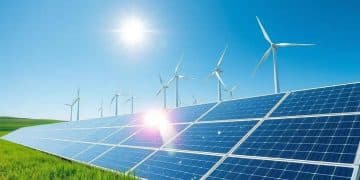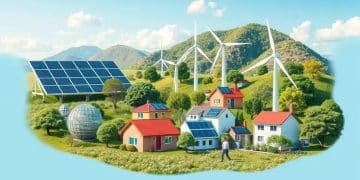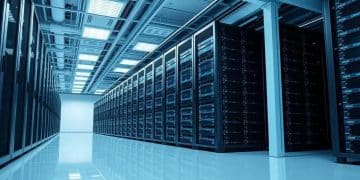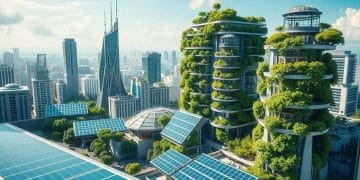Updates on US economic growth 2025: what to expect

Updates on US economic growth for 2025 indicate a promising recovery, driven by sectors such as technology, renewable energy, and healthcare, alongside supportive government policies and increasing consumer confidence.
Updates on US economic growth 2025 are crucial for anyone looking to understand future market trends. With shifts in policies and global events, how prepared are we for what’s next?
current economic indicators for 2025
The current economic indicators for 2025 play a vital role in understanding the direction of the US economy. These indicators help business owners, policymakers, and consumers make informed decisions. In the coming years, several factors will shape the economic landscape.
Key Indicators to Watch
Investors and analysts will be closely monitoring these key indicators:
- GDP growth rates: This measures the overall economic output and health.
- Unemployment rates: Tracking job creation trends will provide insights into labor market strength.
- Inflation rates: Understanding how prices change can help gauge economic stability.
- Consumer confidence index: This reflects how optimistic consumers are about economic prospects.
Additionally, business investments will be pivotal. A surge in investments often signals optimism about future growth, indicating businesses are expanding and creating jobs. In 2025, sectors such as technology and renewable energy are expected to lead in investment growth.
Furthermore, international trade dynamics in 2025 will influence domestic economic indicators. As trade relationships evolve, export and import levels will reflect changes in global markets, affecting everything from job availability to consumer prices.
The Role of Government Policies
Government decisions will also significantly impact economic indicators. Policies aimed at stimulating growth, such as tax incentives and infrastructure spending, can lead to improved job creation and GDP growth. It will be essential to observe the reactions of the financial markets following these policy announcements.
The interplay between these economic indicators creates a complex picture, revealing how the economy adapts and evolves. As these factors unfold, stakeholders should remain vigilant to understand their implications better.
key sectors driving the growth

Identifying the key sectors driving the growth of the economy is essential for anticipating trends and making informed decisions. In 2025, certain industries are expected to lead the charge, significantly impacting economic performance.
Technology Sector
The technology sector is at the forefront of innovation and economic expansion. Advances in artificial intelligence and machine learning are creating new job opportunities and improving productivity. Companies are investing heavily in technology to drive efficiency and scalability. From software development to cybersecurity, this sector will continue to thrive.
- Artificial Intelligence: Enhancing various industries through automation.
- Cybersecurity: Protecting data as digital threats grow.
- Cloud Computing: Facilitating remote work and data storage solutions.
Moreover, every business is rapidly integrating technology into its operations, which will solidify the tech sector’s dominance.
Renewable Energy
Another sector poised for significant growth is renewable energy. Increasing concerns about climate change and sustainability are driving investment in solar, wind, and other renewable sources. This trend not only creates jobs but also helps the U.S. reduce its reliance on fossil fuels.
Government incentives and public awareness are propelling this sector forward. Homeowners are increasingly installing solar panels, while businesses are committing to cleaner energy practices. These shifts reflect a growing commitment to environmental responsibility.
Healthcare Industry
The healthcare sector will continue to expand due to an aging population and advancements in medical technology. Increased demand for healthcare services will create new jobs ranging from nursing to telehealth specialists. Innovations in biotechnology are also leading to new treatments and therapies, improving patient outcomes.
As these industries evolve, they will drive overall economic growth. Understanding these trends can help consumers and businesses alike adapt to changing market conditions.
government policies influencing the recovery
Government policies influencing the recovery are critical as the economy aims to bounce back stronger in 2025. These policies can accelerate growth and foster stability. Understanding how they impact various sectors is essential for businesses and consumers alike.
Fiscal Policies
Fiscal policies, which include government spending and taxation, play a crucial role in economic recovery. Increased government spending can stimulate economic activity, leading to job creation and increased consumer confidence. Tax cuts or benefits can encourage spending and investment, adding momentum to the recovery.
- Infrastructure Investment: Upgrading roads, bridges, and public transport can create jobs.
- Social Programs: Support for unemployment benefits helps maintain consumer spending.
- Tax Incentives: Reducing taxes for businesses can encourage expansion and hiring.
These approaches aim to create a stronger economic foundation and uplift various sectors impacted by the downturn.
Monetary Policies
In addition to fiscal measures, monetary policies set by the Federal Reserve are crucial. The Fed adjusts interest rates to either stimulate or cool down the economy. Lowering interest rates can encourage borrowing and investing, making it easier for businesses to expand.
Furthermore, quantitative easing, where the Fed purchases securities, increases money supply in the economy, supporting recovery efforts. This influences consumer spending by making loans cheaper, helping individuals buy homes and cars, which boosts other industries.
Regulatory Policies
Regulatory changes can also expedite recovery. Simplifying regulations can foster a friendly business environment, encouraging entrepreneurship and innovation. Streamlined processes for starting a business can lead to job creation, essential in a recovering economy.
Understanding these policies and their implications can provide valuable insights into the economic environment and how best to navigate it as changes occur.
predictions from economic experts

Predictions from economic experts play a vital role in shaping expectations for the future of the economy. These forecasts help individuals and businesses prepare and strategize for upcoming changes.
Economic Growth Forecasts
Many experts predict a gradual recovery in economic growth as we move towards 2025. This recovery is expected to be fueled by increased consumer spending and business investment. According to analysts, robust growth rates can lead to more job opportunities and a stronger labor market.
- GDP Growth: Some forecasts suggest that GDP could grow by around 3% to 4% annually.
- Unemployment Rates: Experts expect unemployment to decrease as businesses rebound and expand.
- Inflation Trends: Inflation may stabilize, reflecting a healthier overall economy.
Such predictions give insight into the potential for economic stabilization and expansion.
Sector-Specific Insights
Additionally, predictions indicate that certain sectors will outpace others in growth. Industries such as technology, healthcare, and renewable energy are expected to flourish. This growth is often attributed to ongoing trends like digital transformation, an aging population, and increased investment in clean energy. Economic experts are optimistic about the technological advancements that will drive efficiency and productivity across these sectors.
Moreover, international relations and trade agreements will also impact growth. Experts believe that resolving trade tensions could lead to improved export import relationships, further boosting economic prospects.
Consumer Confidence and Spending
Ultimately, consumer confidence will play a crucial role in economic recovery. Predictions suggest that rising confidence levels will lead to increased spending, which is a significant driver of economic growth. Analysts are hopeful that as people feel more secure in their jobs and finances, they will be more willing to spend on goods and services.
These predictions provide a roadmap for understanding where the economy might be headed and how different elements will interact as markets evolve.
In summary, understanding the updates on US economic growth for 2025 reveals a complex but promising landscape. Key sectors like technology, renewable energy, and healthcare are set to drive growth. Government policies will influence recovery, with fiscal and monetary measures playing significant roles. Expert predictions point to a gradual recovery fueled by increased consumer confidence and spending. As we look forward, staying informed about these trends will be crucial for navigating the evolving economic landscape.
FAQ – Frequently Asked Questions about US Economic Growth 2025
What sectors are expected to drive economic growth in 2025?
Key sectors expected to drive growth include technology, renewable energy, and healthcare, as they adapt and innovate for the future.
How will government policies influence economic recovery?
Government policies, such as fiscal and monetary measures, play a crucial role in stimulating growth and creating jobs through investments and incentives.
What predictions do experts have for GDP growth?
Experts predict that GDP may grow by about 3% to 4% annually as consumer spending and business investments increase.
How does consumer confidence impact the economy?
Increased consumer confidence typically leads to higher spending, which is vital for economic recovery and growth.





